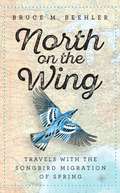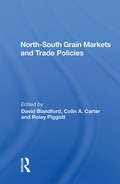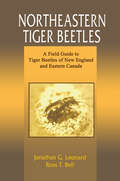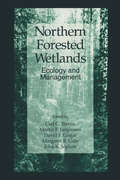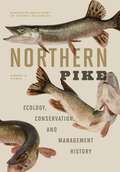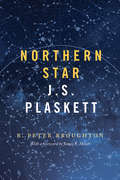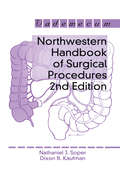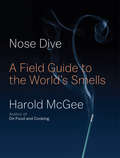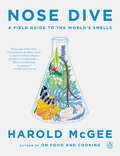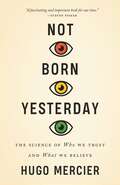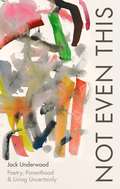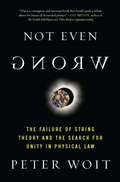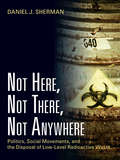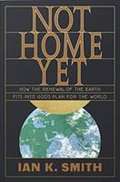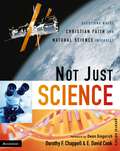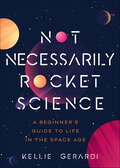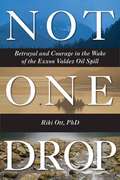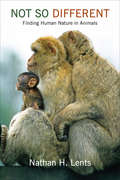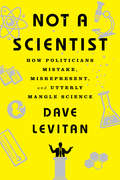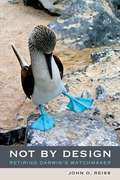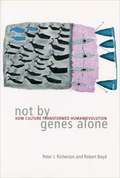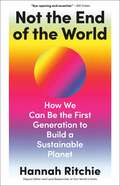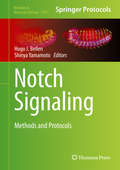- Table View
- List View
North on the Wing: Travels with the Songbird Migration of Spring
by Bruce M. Beehler John T. AndertonThe story of an ornithologist's journey to trace the spring migration of songbirds from the southern border of the United States through the heartland and into Canada.In late March 2015, ornithologist Bruce M. Beehler set off on a solo four-month trek to track songbird migration and the northward progress of spring through America. Traveling via car, canoe, and bike and on foot, Beehler followed woodland warblers and other Neotropical songbird species from the southern border of Texas, where the birds first arrive after their winter sojourns in South America and the Caribbean, northward through the Mississippi drainage to its headwaters in Minnesota and onward to their nesting grounds in the north woods of Ontario. In North on the Wing, Beehler describes both the epic migration of songbirds across the country and the gradual dawning of springtime through the U.S. heartland--the blossoming of wildflowers, the chorusing of frogs, the leafing out of forest canopies--and also tells the stories of the people and institutions dedicated to studying and conserving the critical habitats and processes of spring songbird migration. Inspired in part by Edwin Way Teale's landmark 1951 book North with the Spring, this book--part travelogue, part field journal, and part environmental and cultural history--is a fascinating first-hand account of a once-in-a-lifetime journey. It engages readers in the wonders of spring migration and serves as a call for the need to conserve, restore, and expand bird habitats to preserve them for future generations of both birds and humans.
North-South Grain Markets And Trade Policies
by David BlandfordThe book is composed of a series of case studies. The countries included reflect the interest and experience of the authors who collaborated in preparing the volume. No attempt was made to provide representative coverage based upon a comprehensive classiftcation of countries, which is why there are no chapters dealing with such exporters as Argentina or Thailand or importers such as Egypt or Japan. Despite the somewhat eclectic geographical mix, many of the fundamental issues that face the North and the South, both individually and collectively, are illustrated by the case countries. We would argue that there is much to be learned about the effective implementation of policy choices and the constraints that policymakers face by looking at individual country experiences, rather than by attempting to generalize on the basis of an abstract theoretical framework There is a dearth of information on what countries actually do in managing domestic grain markets.
Northeastern Tiger Beetles: A Field Guide to Tiger Beetles of New England and Eastern Canada
by Jonathan G. LeonardNortheastern Tiger Beetles: A Field Guide to Tiger Beetles of New England and Eastern Canada is the first book to draw together information about adult and larvae of tiger beetles of New England and Eastern Canada. Details are provided about key characteristics of adults and larvae; habitat; range; and life history information of the various species, including notes on conservation status of rare or endangered species.
Northern Forested Wetlands Ecology and Management
by Carl C. TrettinForested wetlands are a major component of northern landscapes, important both for their ecological functions and their socioeconomic values. Historically, these lands have been used for timber and fiber products, hunting, fishing, trapping, food gathering, and recreation. There are many questions about the use and management of these lands in the future, particularly with respect to forest products, hydrology and water quality, plant and wildlife ecology, landscape dynamics, and wetland restoration. Northern Forested Wetlands: Ecology and Management provides a synthesis of current research and literature. It examines the status, distribution, and use of these wetland resources. The book focuses on understanding the role of wetlands in the landscape and on how to manage these wetlands and sustain their important functions. This is a primary reference text for the study and management of northern forested wetlands, providing a forum for information discovered by researchers and managers from many nations.
Northern Pike: Ecology, Conservation, and Management History
by Rodney B. PierceThe northern pike—sometimes affectionately known as the &“aquatic wolf&”—is one of the most sought after and mythologized fishes in Minnesota, but until now there have been few books devoted to the history and ecological management of the species. Based on pioneering research carried out in Minnesota by leading pike specialist Rodney B. Pierce, Northern Pike Ecology, Conservation, and Management History is the most complete collection of information to date on the species, for everyone from scientists and conservation biologists to general readers and recreational anglers.A tremendously important game fish and resource both in Minnesota and throughout the northern hemisphere, northern pike populations directly reflect local geology and human influence, playing a key role in the health of freshwater ecosystems. As urbanization spreads and the human population continues to grow, pike populations face increasing pressure, requiring new ways of looking at and managing the species. In Minnesota, groundbreaking work has been conducted on northern pike: analyses of stocking success and investigations into the relationships within fish communities, the management of rearing marshes, environmental effects on natural production, the genetics of northern pike, and strategies for scientifically monitoring pike. The state has been a leader in developing fishing regulations to help restore large pike, among many other measures designed to ensure the future quantity and health of a key species in Minnesota&’s waterways.Weaving significant historical scientific literature and technical details together with his own research, Pierce&’s benchmark study documents and synthesizes the long history of northern pike management and describes the latest efforts being taken to better understand and manage this critical and renowned species.
Northern Star: J.S. Plaskett
by R. Peter Broughton James E. HesserJohn Stanley Plaskett was Canada’s pre-eminent astronomer in the first half of the twentieth century. His legacy lives on in the observatory he founded in Victoria, British Columbia, and the reputation he built for Canada as a nation making vital contributions to basic science. Plaskett’s pioneering work with the most massive stars and his definitive determination of the rotation of the Milky Way Galaxy earned him international recognition of the highest order. Northern Star explores Plaskett’s unorthodox and fascinating life from his rural roots near Woodstock, Ontario through his days as a technician at the University of Toronto to his initiation in astronomy at the Dominion Observatory in Ottawa. His greatest achievements followed after he persuaded the government of Canada, in spite of the strictures of the First World War, to finance what was then the world’s largest operational telescope. Peter Broughton’s accessible and engaging prose illuminates Plaskett’s numerous achievements and the social, political, economic, and religious milieu surrounding them. This richly illustrated volume invites readers to understand the pull that Plaskett’s passions, personality, and motivations exerted on him during his lifetime.
Northwestern Handbook of Surgical Procedures
by Richard H. Bell Jr.The Northwestern Handbook of Surgical Procedures, 2nd Edition, is designed to be reviewed prior to performing or participating in an operation. The authors of the book have identified the key steps of performing each procedure, to provide a framework to the learner for understanding the tasks and the sequence of those tasks necessary for successful
Nose Dive: A Field Guide to the World's Smells
by Harold McGeeThe ultimate guide to the smells of the universe--the ambrosial to the pungent, and everything in between--from the author of the acclaimed culinary guides On Food and Cooking and Keys to Good Cooking.From Harold McGee, James Beard Award-winning author and leading expert on the science of food and cooking, comes an extensive exploration of the awe-inspiring world of smell. In Nose Dive, McGee takes us on a sensory-filled adventure, from the sulfurous nascent earth more than four billion years ago, to the sweetly fragrant Tian Shan mountain range north of the Himalayas, to the keyboard of your laptop, where trace notes of formaldehyde escape between the keys. We'll sniff the ordinary (wet pavement and cut grass) and extraordinary (fresh bread and chocolate), the delightful (roses and vanilla) and the unpleasant (spoiled meat and rotten eggs). We'll smell each other. We'll smell ourselves.Through it all, McGee familiarizes us with the actual bits of matter that we breathe in -- the molecules that trigger our perceptions, that prompt the citrusy smells of coriander and beer and the medicinal smells of daffodils and sea urchins. And like everything in the physical world, molecules have histories. Many of the molecules that we smell every day existed long before any creature was around to smell them -- before there was even a planet for those creatures to live on. Beginning with the origins of those molecules in interstellar space, McGee moves onward through the smells of our planet, the air and the oceans, the forest and the meadows and the city, all the way to the smells of incense, perfume, wine, and food. Here is a story of the world, of all of the smells under our collective nose. A work of astounding scholarship and originality, Nose Dive distills the science behind the smells and translates it, as only McGee can, into an accessible and entertaining guide. Incorporating the latest insights of biology and chemistry, and interwoven with personal observations, McGee reveals how our sense of smell has the power to expose invisible, intangible details of our material world and life, and trigger in us feelings that are the very essence of being alive.
Nose Dive: A Field Guide to the World's Smells
by Harold McGeeThe ultimate guide to the smells of the universe - the ambrosial to the malodorous, and everything in between - from the author of the acclaimed culinary guides On Food and Cooking and Keys to Good CookingFrom Harold McGee, James Beard Award-winning author and leading expert on the science of food and cooking, comes an extensive exploration of the awe-inspiring world of smell. In Nose Dive, McGee takes us on a sensory-filled adventure, from the sulfurous nascent earth more than four billion years ago, to the sweetly fragrant Tian Shan mountain range north of the Himalayas, to the keyboard of your laptop, where trace notes of formaldehyde escape between the keys. We'll sniff the ordinary (wet pavement and cut grass) and extraordinary (fresh bread and chocolate), the delightful (roses and vanilla) and the unpleasant (spoiled meat and rotten eggs). We'll smell each other. We'll smell ourselves. Through it all, McGee familiarizes us with the actual bits of matter that we breathe in -- the molecules that trigger our perceptions, that prompt the citrusy smells of coriander and beer and the medicinal smells of daffodils and sea urchins. And like everything in the physical world, molecules have histories. Many of the molecules that we smell every day existed long before any creature was around to smell them -- before there was even a planet for those creatures to live on. Beginning with the origins of those molecules in interstellar space, McGee moves onward through the smells of our planet, the air and the oceans, the forest and the meadows and the city, all the way to the smells of incense, perfume, wine, and food. Here is a story of the world, of all of the smells under our collective nose. A work of astounding scholarship and originality, Nose Dive distills the science behind the smells and translates it, as only McGee can, into an accessible and entertaining guide. Incorporating the latest insights of biology and chemistry, and interwoven with personal observations, McGee reveals how our sense of smell has the power to expose invisible, intangible details of our material world and life, and trigger in us feelings that are the very essence of being alive.
Not A Monster
by Claudia Guadalupe MartínezWith Spanish vocabulary and a clever color concept, this poetic picture book shares the life cycle of beloved amphibian—the axolotl—in its natural habitat.An axolotl may look like one, but it is certainly Not a Monster. This curious creature, made popular by Minecraft, is actually a salamander that will never lose its gills or fins. Not a Monster explores the traits of the axolotl, the Aztec origin myth about the species, and the way pollution is affecting its natural habitat: the canals of Xochimilco in Mexico City. Fun and engaging, this playful and informative read-aloud introduces curious readers on one cool character who is NOT a monster!
Not Born Yesterday: The Science of Who We Trust and What We Believe
by Hugo MercierWhy people are not as gullible as we thinkNot Born Yesterday explains how we decide who we can trust and what we should believe—and argues that we're pretty good at making these decisions. In this lively and provocative book, Hugo Mercier demonstrates how virtually all attempts at mass persuasion—whether by religious leaders, politicians, or advertisers—fail miserably. Drawing on recent findings from political science and other fields ranging from history to anthropology, Mercier shows that the narrative of widespread gullibility, in which a credulous public is easily misled by demagogues and charlatans, is simply wrong.Why is mass persuasion so difficult? Mercier uses the latest findings from experimental psychology to show how each of us is endowed with sophisticated cognitive mechanisms of open vigilance. Computing a variety of cues, these mechanisms enable us to be on guard against harmful beliefs, while being open enough to change our minds when presented with the right evidence. Even failures—when we accept false confessions, spread wild rumors, or fall for quack medicine—are better explained as bugs in otherwise well-functioning cognitive mechanisms than as symptoms of general gullibility.Not Born Yesterday shows how we filter the flow of information that surrounds us, argues that we do it well, and explains how we can do it better still.
Not Even This: Poetry, parenthood and living uncertainly
by Jack Underwood'[A] clever, cosmic, moving and funny parenting physics and poetry adventure . . . It's wonderful' Max Porter via Twitter'Clear, nimble and dexterous' Ocean Vuong'It's a magical book. An incantation to be fully present, fully concerned, fully alive' Luke KennardIn this highly original book-length lyric essay, a father and poet reflects on how his daughter's birth at a time of great global uncertainty inspired him to rediscover with fresh urgency the importance of language as a realm of 'intimacy, overlap, hope and trust'. Poetry can uniquely offer an understanding of the world which brings its complexity within reach - yet does not seek to reduce or explain that complexity away. Poetry is a form through which we might reckon with this uncertain world, learn to inhabit our precarious life more fluently and, in turn, offer what we learn to our children.From Joan of Arc to the unfathomable gravity of supermassive black holes, from metaphor to quantum mechanics, Not Even This is a moving, thought-provoking work, full of delights. Jack Underwood is open and attentive to the questions that the world and his daughter continue to present: thrilling, terrifying, fundamental.
Not Even Wrong: The Failure of String Theory and the Search for Unity in Physical Law for Unity in Physical Law
by Peter WoitWhen does physics depart the realm of testable hypothesis and come to resemble theology? Peter Woit argues that string theory isn't just going in the wrong direction, it's not even science. Not Even Wrong shows that what many physicists call superstring "theory" is not a theory at all. It makes no predictions, not even wrong ones, and this very lack of falsifiability is what has allowed the subject to survive and flourish. Peter Woit explains why the mathematical conditions for progress in physics are entirely absent from superstring theory today, offering the other side of the story.
Not Here, Not There, Not Anywhere: Politics, Social Movements, and the Disposal of Low-Level Radioactive Waste
by Daniel J. ShermanIn 1979, provoked by the Three Mile Island nuclear accident, governors of states hosting disposal facilities for low-level radioactive waste (LLRW) refused to accept additional shipments. The resulting shortage of disposal sites for wastes spurred Congress to devolve responsibility for establishing new, geographically diffuse LLRW disposal sites to states and regional compacts, with siting authorities often employing socio-economic and political data to target communities that would give little resistance to their plans. The communities, however, were far from compliant, organizing nearly 1000 opposition events that ended up blocking the implementation of any new disposal sites. Sherman provides comprehensive coverage of this opposition, testing hypotheses regarding movement mobilization and opposition strategy by analyzing the frequency and disruptive qualities of activism. In the process, he bridges applied policy questions about hazardous waste disposal with broader questions about the dynamics of social movements and the intergovernmental politics of policy implementation. The issues raised in this book are sure to be renewed as interest grows in nuclear power and the disposal of the resulting waste remains uncertain.
Not Home Yet: How the Renewal of the Earth Fits into God's Plan for the World
by Ian K. SmithBeginning with the creation of the heavens and earth and ending with the New Jerusalem, the storyline of Scripture reveals God’s commitment to the physical world that he created. Our final destiny is not some disembodied, heavenly existence but rather life with God on a renewed earth. How does this understanding of our future home affect our lives today? What role should Christians play in meeting physical needs? Are spiritual realities more significant than physical? This book will help us understand God's eternal vision for the renewal of this earth and discover purpose in all of our daily, real-world endeavors, such as work, the arts, social justice, ecology, medicine, and more.
Not Just Science: Questions Where Christian Faith and Natural Science Intersect
by Dorothy F. Chappell E. David CookThis book argues that it is possible for our study of the natural world to enhance our understanding of God and for our faith to inform and influence our study and application of science. Whether you are a student, someone employed in the sciences, or simply an interested layperson, Not Just Science will help you develop the crucial skills of critical thinking and reflection about key questions in Christian faith and natural science. The contributors provide a systematic approach to both raising and answering the key questions that emerge at the intersection of faith and various disciplines in the natural sciences. Among the questions addressed are the context, limits, benefits, and practice of science in light of Christian values. Questions of ethics as they relate to various applied sciences are also discussed. The end goal is an informed biblical worldview on both nature and our role in obeying God’s mandate to care for his creation. With an honest approach to critical questions, Not Just Science fills a gap in the discussion about the relationship between faith and reason. This is a most welcomed addition to these significant scholarly conversations. Ron Mahurin, PhD Vice President, Professional Development and Research Council for Christian Colleges & Universities
Not Necessarily Rocket Science: A Beginner's Guide to Life in the Space Age
by Kellie GerardiFollow one woman&’s non-traditional path in the space industry as she guides and encourages anyone who has ever dreamed about life in outer space. In this candid science memoir and career guide, aerospace science professional Kellie Gerardi offers an inside look into the industry beginning to eclipse Silicon Valley. Whether you have a space science degree or are looking to learn about stars and the solar system, Not Necessarily Rocket Science proves there&’s room for anyone who is passionate about exploration. With a space background and a mission to democratize access to space, this female astronaut candidate offers a front row seat to the final frontier. From her adventures training for Mars to testing spacesuits in microgravity, this unique handbook provides inspiration and guidance for aspiring astronauts everywhere. Look inside for answers to questions like: Will there be beer on Mars? Why do I need to do one-handed pushups in microgravity? How can I possibly lose a fortune in outer space? Praise for Not Necessarily Rocket Science &“Blasts readers onto a rocket-fueled journey through space and time, the perfect primer for the next space age.&”―Zara Stone, author of The Future of Science is Female &“Kellie is probably one of the best ambassadors for spaceflight in the 21st century that the industry could have.&”―Lucy Hawking, author of George&’s Secret Key to the Universe and host of Audible&’s Lucy in the Sky. &“Unique and compelling…will appeal to anyone whose dreams are larger than the limitations others try to wrap them in. Gerardi is informed, inspiring, and full of humanity, as she takes readers on a personal journey into what it means to be a fully signed-up member of the space age. A must-read for space-dreamers everywhere!&”―Andrew Maynard, Author of Future Rising &“Space may seem like a pretty intimidating place, open only to fighter pilots or brilliant engineers. But if humans are to ever settle worlds beyond Earth, it will take all kinds to make a society. That's where Not Necessarily Rocket Science comes in―a book that makes space accessible and fun, while showing readers where the front door is…. Kellie Gerardi deftly offers a sampling of the possible careers in space while helping those who are intrigued find their own pathway. Space needs more engineers, sure. But as Gerardi ably writes, it needs poets too.&”―Eric Berger, senior space editor at Ars Technica
Not One Drop: Betrayal and Courage in the Wake of the Exxon Valdez Oil Spill
by Riki OttShocking, factual, and inspiring, Not One Drop traces the twenty-year trail of Cordova, Alaska, residents as they cope with the largest oil spill and one of the longest-running court cases in U.S. history--and, ultimately, the failure of Exxon to come through on its promise to compensate them adequately for their losses and clean up their environment after the Exxon Valdez oil spill.
Not So Different: Finding Human Nature in Animals
by Nathan H. LentsAnimals fall in love, establish rules for fair play, exchange valued goods and services, hold "funerals" for fallen comrades, deploy sex as a weapon, and communicate with one another using rich vocabularies. Animals also get jealous and violent or greedy and callous and develop irrational phobias, just like us. Monkeys address inequality, wolves miss each other, elephants grieve for their dead, and prairie dogs name the humans they encounter. Human and animal behavior is not as different as once believed.In Not So Different, the biologist Nathan H. Lents argues that the same evolutionary forces of cooperation and competition have shaped both humans and animals. Identical emotional and instinctual drives govern our actions. By acknowledging this shared programming, the human experience no longer seems unique, but in that loss we gain a fuller appreciation of such phenomena as sibling rivalry and the biological basis of grief, helping us lead more grounded, moral lives among animals, our closest kin. Through a mix of colorful reporting and rigorous scientific research, Lents describes the exciting strides scientists have made in decoding animal behavior and bringing the evolutionary paths of humans and animals closer together. He marshals evidence from psychology, evolutionary biology, cognitive science, anthropology, and ethology to further advance this work and to drive home the truth that we are distinguished from animals only in degree, not in kind.
Not Your Mother's Make-Ahead and Freeze Cookbook
by Jessica FisherFisher serves up more than 250 recipes for delectable breakfasts, lunches, and dinners with the secret weapon of “batch cooking”, which saves both time and money. <P><P>This cookbook puts a modern spin on the age-old idea of freezing meals for later, and appeals to today's diverse tastes.
Not a Scientist: How Politicians Mistake, Misrepresent, and Utterly Mangle Science
by Dave LevitanAn eye-opening tour of the political tricks that subvert scientific progress. The Butter-Up and Undercut. The Certain Uncertainty. The Straight-Up Fabrication. Dave Levitan dismantles all of these deceptive arguments, and many more, in this probing and hilarious examination of the ways our elected officials attack scientific findings that conflict with their political agendas. The next time you hear a politician say, "Well, I’m not a scientist, but…," you’ll be ready.
Not by Design: Retiring Darwin's Watchmaker
by John O. ReissThe author tries to show that the concept of natural selection is often invoked to explain evolutionary transformations for which we have no evidence that the mechanism of natural selection, as currently understood, was wholly or even partially responsible for the transformation.
Not by Genes Alone: How Culture Transformed Human Evolution
by Peter J. Richerson Robert BoydA groundbreaking theory of the role of culture in evolution, this book offers a radical interpretation of human evolution, arguing that our ecological dominance and our singular social systems stem from a psychology uniquely adapted to create complex culture.
Not the End of the World: How We Can Be the First Generation to Build a Sustainable Planet
by Hannah RitchieThis "eye-opening and essential" book (Bill Gates) will transform how you see our biggest environmental problems—and explains how we can solve them. It&’s become common to tell kids that they&’re going to die from climate change. We are constantly bombarded by doomsday headlines that tell us the soil won&’t be able to support crops, fish will vanish from our oceans, and that we should reconsider having children. But in this bold, radically hopeful book, data scientist Hannah Ritchie argues that if we zoom out, a very different picture emerges. In fact, the data shows we&’ve made so much progress on these problems that we could be on track to achieve true sustainability for the first time in human history. Did you know that: Carbon emissions per capita are actually down Deforestation peaked back in the 1980s The air we breathe now is vastly improved from centuries ago And more people died from natural disasters a hundred years ago? Packed with the latest research, practical guidance, and enlightening graphics, this book will make you rethink almost everything you&’ve been told about the environment. Not the End of the World will give you the tools to understand our current crisis and make lifestyle changes that actually have an impact. Hannah cuts through the noise by outlining what works, what doesn&’t, and what we urgently need to focus on so we can leave a sustainable planet for future generations. These problems are big. But they are solvable. We are not doomed. We can build a better future for everyone. Let&’s turn that opportunity into reality.
Notch Signaling
by Hugo J. Bellen Shinya YamamotoNotch Signaling: Methods and Protocols focuses on molecular, biochemical and bioinformatics aspects of Notch signaling. Chapters analyze the Notch interactome, post-translational modifications of Notch, ligand binding assays, methods to assess proteolytic cleavage and transcriptional targets. Written in the highly successful Methods in Molecular Biology series format, chapters include introductions to their respective topics, lists of the necessary materials and reagents, step-by-step, readily reproducible laboratory protocols and key tips on troubleshooting and avoiding known pitfalls. Authoritative and practical, Notch Signaling: Methods and Protocols is a valuable contribution to hundreds of labs and thousands of scientists who pursue this research area with vigor.
